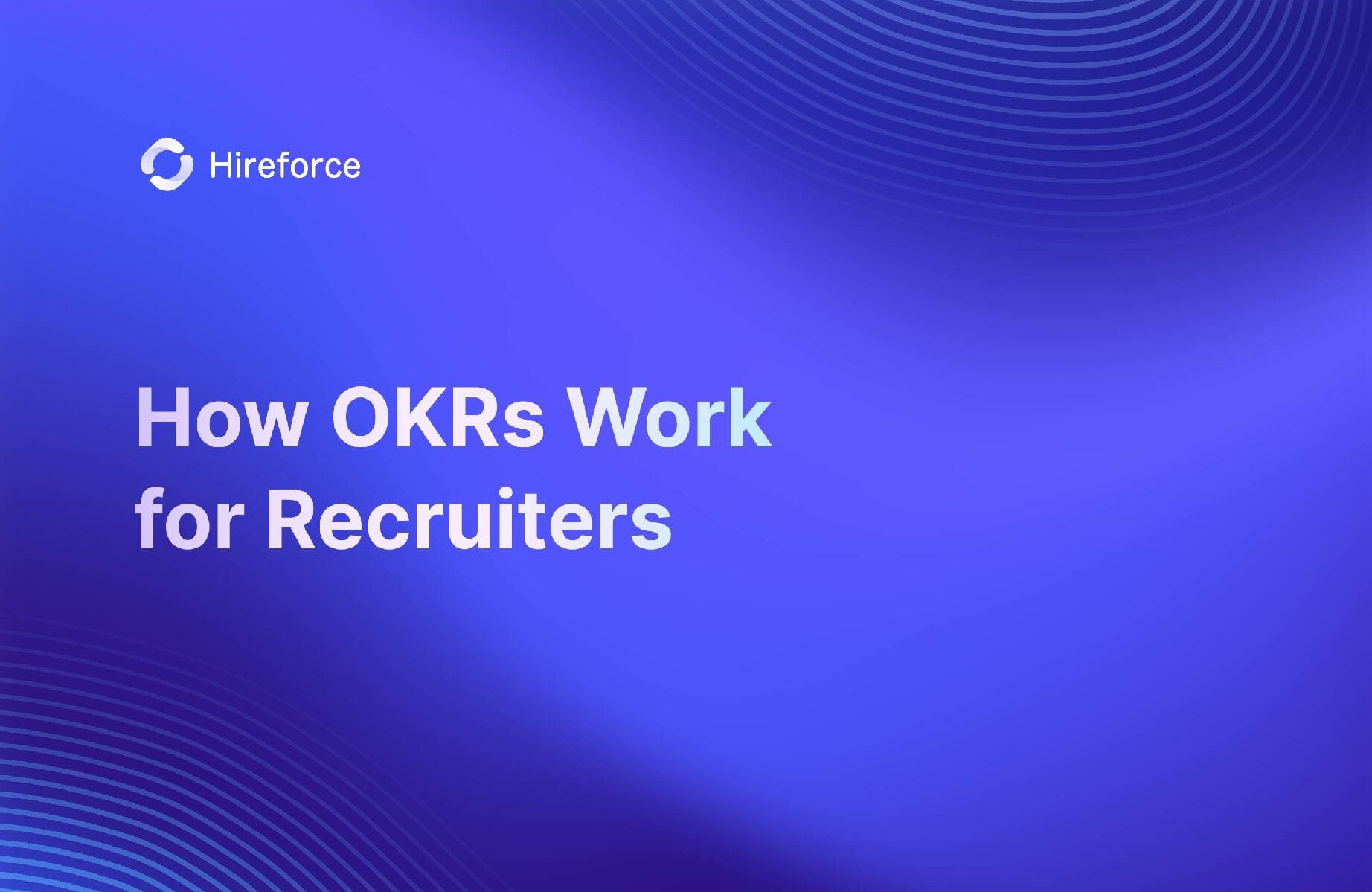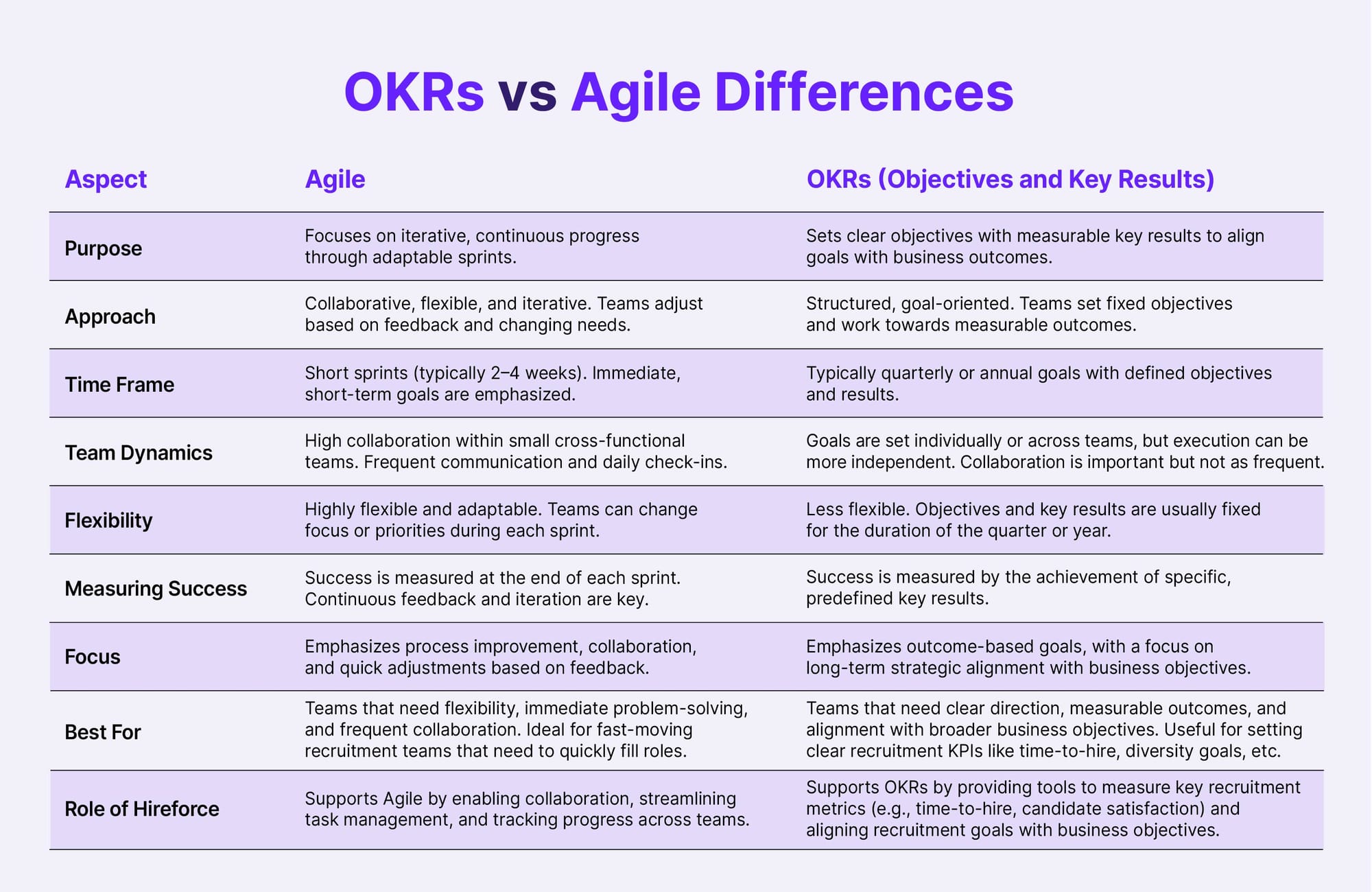Recruitment teams increasingly adopt structured frameworks to streamline hiring processes, enhance collaboration, and boost performance. OKRs (Objectives and Key Results) and Agile are the most popular methodologies. This blog breaks down both systems, explores their relevance in recruitment, and provides a guide on choosing the right one for your team.
What are OKRs?
Objectives and Key Results (OKRs) is a goal-setting framework that helps organizations define and track measurable objectives. OKRs are typically structured around a clear objective, what you want to achieve, measurable key results, and how you'll track progress toward that goal.
What are OKRs used for?
OKRs help teams focus on clear, defined goals. This could mean improving the time to hire, increasing candidate satisfaction, or enhancing diversity metrics for recruitment. OKRs are commonly used in quarterly cycles and promote transparency and alignment across teams, ensuring everyone is working toward the same priorities.

Best practices for applying OKRs in recruitment
- Set clear objectives: Start with specific, high-impact goals, such as "Reduce the time-to-hire for software engineers."
- Define measurable key results: Break objectives into measurable steps, like "reduce time-to-hire from 45 days to 30 days."
- Align with company goals: Ensure recruitment OKRs align with broader company objectives, such as business growth or culture improvements.
- Regular check-ins: Hold weekly or biweekly reviews to assess progress and adjust efforts as needed.
- Foster transparency: Make OKRs visible to the team to promote accountability and alignment.
What is Agile?
Agile is a project management methodology emphasizing flexibility, collaboration, and iterative progress. In recruitment, Agile can be applied to adapt to the changing needs of hiring managers and candidates, prioritize tasks based on urgency, and quickly pivot strategies when necessary.
What is Agile used for?
Agile is particularly effective when applied to complex, dynamic processes like hiring. Agile frameworks like Scrum or Kanban allow recruitment teams to operate in "sprints," focusing on short-term goals like filling high-priority roles or refining candidate pipelines. Agile enables recruiters to be responsive to immediate changes in hiring demands.
Best practices for applying Agile in recruitment
- Adopt sprints: Break recruitment tasks into short, focused periods (sprints), usually lasting 1–2 weeks. Prioritize urgent roles or tasks for each sprint.
- Daily stand-ups: Hold short meetings to discuss progress, challenges, and next steps.
- Kanban boards: Use visual task boards to track the progress of candidates, job postings, and interviews.
- Iterative feedback: After each sprint, collect feedback from hiring managers, candidates, and recruiters and adjust strategies accordingly.
- Cross-functional collaboration: Engage with various stakeholders, such as HR, department heads, and hiring managers, to ensure alignment.
OKRs and Agile: What's the difference?
While OKRs and Agile share some commonalities, such as emphasized alignment and focus, they differ significantly in approach.

What should recruiters use?
The benefits of OKRs:
- Clarity and focus: OKRs provide recruitment teams with clear, measurable goals, helping them focus on impactful metrics like time-to-fill or candidate diversity.
- Alignment: Recruitment OKRs can be aligned with broader business objectives, such as scaling headcount during growth phases.
- Measurement of success: With defined key results, recruitment teams can quantitatively assess their success and areas for improvement.
The benefits of Agile:
- Flexibility: Agile's iterative nature allows recruitment teams to adapt quickly to new hiring needs or challenges.
- Efficiency: By breaking tasks into short sprints, Agile promotes continuous progress and quick resolutions to bottlenecks.
- Collaboration: Agile's emphasis on regular check-ins and feedback ensures that hiring managers and recruiters are always on the same page.
Questions to choose the best fit
Is your recruitment process stable or dynamic?
If your hiring needs remain relatively constant and you're focused on long-term goals, OKRs might be a better fit. However, if your team faces frequent shifts in hiring priorities, Agile offers the flexibility to adapt quickly.
How important is goal tracking in your recruitment process?
OKRs work well to track and measure specific recruitment KPIs over time. Agile, on the other hand, emphasizes ongoing improvement and problem-solving.
What is the team's workflow preference?
Does your team thrive on clear, structured goals (OKRs), or do they perform better in a fast-paced, iterative environment (Agile)?
How involved are your stakeholders in the recruitment process?
Agile might be more suitable if frequent feedback from hiring managers or department heads is required. OKRs can work better for teams with stable, long-term recruitment goals.





